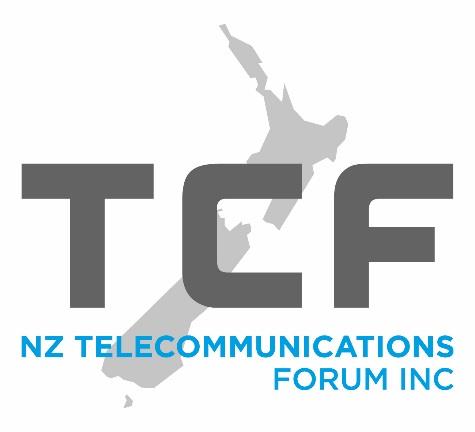
31 October 2022
To:
His Worship the Mayor
Wayne Brown
Auckland Council
By email:
[email address]
Dear Mayor Brown,
Improving Auckland’s Mobile Coverage
Firstly, I’d like to congratulate you on your election win, the New Zealand Telecommunications Forum
(referred to as the TCF) looks forward to working with you and Auckland Council on telecommunications
services across the Auckland region.
The TCF is the industry association which brings the telecommunications sector together to resolve
regulatory, technical and policy issues to ensure New Zealanders have the best possible telecommunication
service available. Our members represent over 95% of the telecommunications customers in New Zealand.
I’ve been asked to respond to your letter to the mobile operators dated 16 October 2022,
Fixing Phone
Service in Auckland Council Region, as a pan-industry representative and to add a little more detail to the
communications you’ll be receiving from the mobile operators themselves.
New Zealand should rightly be proud of the telecommunications infrastructure available today. Investment
in the mobile networks increased by 10% to $274 million, the increase predominately attributed to the
ongoing rollout of the 5G network and total telecommunications investment reached $1.62 billion in 20211.
By the end of this year, 87% of New Zealanders will have access to fibre-to-the-premises, putting us among
the leaders in the world for fibre to the home deployments. Our mobile networks provide coverage to 98.5%
of the population and our fiercely competitive market ensures that prices are kept on par with the best in
the developed world.
Of course, consumers of mobile services by their very nature move around and expect coverage as they do
so and that’s something that requires an ongoing level of investment and support unlike any other
infrastructure. In addition, mobile networks are delivering increasingly more for consumers. Exponential
growth in the use of data is continuing and each year the amount of data handled by telecommunications
networks roughly doubles.2 To keep up with demand and ensure that networks are uncongested, operators
need to build more cell sites in urban areas and densify the grid. Ensuring mobile network capacity is
available to a market that travels from city to beach and beyond is a constant challenge for mobile providers
all around the world. As customer needs change the network must be able to flex to meet those needs.
Thankfully we have a regulatory regime that largely supports investment and growth in many parts of the
country.
You specifically asked if there is anything Council can do to support the rollout of mobile services to improve
coverage across the Auckland region and the answer is a resounding yes on a number of fronts.
1 2021 Annual Telecommunications Monitoring Report 17 March 2022
2 2021 Annual Telecommunications Monitoring Report 17 March 2022
New Zealand Telecommunications Forum Incorporated (TCF)
PO Box 65503, North Shore, Auckland
Tel: + 64 9 475 0203 Fax: + 64 9 479 4530
Email: [email address] Web: www.tcf.org.nz
Support for National Environmental Standards for Telecommunications Facilities (NESTF)
As local Government moves to apply the new medium density residential standards implements required by
the Resource Management (Enabling Housing Supply and Other Matters) Amendment Act 2021 (the Act), it
is vital that the existing standards that support deployment and upgrades of mobile infrastructure are
maintained and updated during this time. Having Auckland Council support for that work by making any
enabling and consequential changes to Auckland plans - and supporting updating of national requirements –
will ensure continued mobile network investment for the expansion of Auckland and its communities.
For example, cellular equipment mounted on street poles are limited in terms of height based on building
designs developed more than a decade ago. Today, our town centres and suburban streets are growing up
as quickly as they are out, which means we need to amend the NESTF to allow for taller poles. Council
support to ensure Auckland plans reflect the new medium density standards and to actively engage the
Ministry of Business, Innovation and Employment and Ministry for the Environment to facilitate these types
of changes to the NESTF would be welcome.
Resource consents
Perhaps the most important role Council plays in the deployment of our telecommunications networks is as
a consenting agent. Currently, instead of the required 20 working days to deliver a simple consent, we are
often faced with delays of four to six weeks. Council request data that is not necessarily needed or relevant
to the application such as visual amenity reports for a mast along a highway corridor in the Strategic
Transport Zone. What should be a relatively simple application under current legislation can become bogged
down in detail, requiring additional time and resources from both Council and the telecommunications
operators. Having a dedicated team of consent planners who understand the complex regulatory framework
of the National Environmental Standards for Telecommunication Facilities (NESTF) and the Infrastructure
Chapter E26 of the Unitary Plan would speed up consenting. We would be open to providing education on
the industry and the NESTF to Council as required. This would support achieving the Council’s objective to
process resource consents within 20 working days.
Auckland Transport general road designation
Around eight years ago, prior to the introduction of the Auckland Unitary Plan, Auckland Transport lodged a
notice of requirement (Designation) in favour of Auckland Transport activities over all the roads in the city.
Consequently, installing new telecommunications infrastructure, such as a cabinet, backhaul infrastructure
or a new cell site, requires an additional approval process for the Auckland Unitary Plan and Corridor Access
Request, on top of the NESTF. Auckland Transport and Auckland Council continue to refuse to progress this
Designation to a hearing or withdraw the Designation. The result is an unreasonable delay over and above
the statutory process under the RMA.
New sub-divisions
Urban development and subdivisions should be required to engage with telecommunications infrastructure
providers as early as possible so the allocation of designated cell site space is included as part of the consent
process, rather than retrospectively once residents start to move in. Gaining access to install cell sites
retrospectively once a development has been established can prove difficult, divisive and time consuming.
Council support in making sure a developer is required to ensure adequate provision of essential
telecommunications infrastructure would help speed up the rollout of services and support those
communities. The National Policy Statement Urban Development requires engagement with
Telecommunications Operators to enable the provision of infrastructure to support high growth areas.
Council support in this would be well received.
High rise buildings
As we intensify our city, access to roof space for antenna should be mandated for telecommunications
infrastructure as it currently is for electricity and water networks. As the city scape changes, existing
infrastructure can be built out, meaning new high-rise buildings can block radio signals - but can also provide
a vital platform for mobile network connectivity. We suggest that developers should be required to consult
telecommunications operators and a fair use policy on private and public buildings be developed so
infrastructure can easily be deployed to meet our city’s growing needs.
New Zealand Telecommunications Forum Incorporated (TCF)
PO Box 65503, North Shore, Auckland
Tel: + 64 9 475 0203 Fax: + 64 9 479 4530
Email: [email address] Web: www.tcf.org.nz
 Road access and road closure notices
Road access and road closure notices
Mobile networks aren’t just cell sites and poles – we also require electricity supply and fibre connectivity to
carry the data to the network. Improving and automating the road access and road closure processes to be
faster and more transparent would help with new deployments. Currently the process is opaque and
involves a lot of passing information back and forth between the telecommunications infrastructure
providers and Council departments such as Auckland Transport. This adds time, complexity and cost to any
deployment. We suggest streamlining this process to automatically permit the installation of
telecommunications infrastructure, with appropriate safety and traffic management considerations.
It’s clear we share a view that Auckland is a world class city and where we value the importance of all of its
citizens being digitally connected to engage and participate within their communities for health, wellbeing,
education and social participation. Telecommunications infrastructure must be seen as the essential service
it is, and network growth must be given priority if we’re to achieve that goal.
We would be delighted to engage with both your office and the wider Council on this matter and I look
forward to working alongside your officials and staff to ensure we can deliver the telecommunications
networks that Auckland deserves.
Ngā mihi nui
Paul Brislen
Chief Executive Officer
New Zealand Telecommunications Forum (TCF)
New Zealand Telecommunications Forum Incorporated (TCF)
PO Box 65503, North Shore, Auckland
Tel: + 64 9 475 0203 Fax: + 64 9 479 4530
Email: [email address] Web: www.tcf.org.nz

